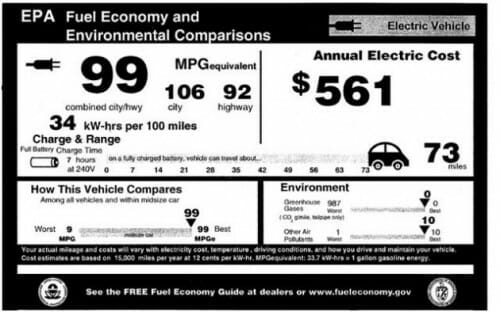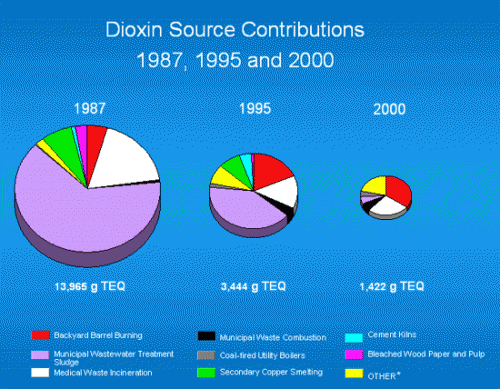Update: True MPGe is closer to 36, see below. The 36 actually comes from the government's own research and rule-making, which they have chosen to ignore.
The EPA has done the fuel economy rating for the all-electric Nissan Leaf. I see two major problems with it, but first, here is the window sticker, from this article

Problem #1: Greenhouse gas estimate is a total crock. Zero?
The Greenhouse gas rating, in the bottom right corner, is that the car produces ZERO greenhouse gasses. While I suppose this is technically true, it is wildly misleading. In almost every case, the production of the electricity to charge the car does create greenhouse gasses. One might argue the answer is zero in the Pacific Northwest where most power is hydro, but even in heavy hydro/nuclear areas, the incremental marginal demand is typically picked up by natural gas turbines. And in the Midwest, the Leaf will basically be coal powered, and studies have shown it to create potentially more CO2 than burning gasoline. I understand that this metric is hard, because it depends on where you are and even what time of day you charge the car, but the EPA in all this complexity chose to use the one number - zero - that is least likely to be the correct answer.
Problems #2: Apples and oranges comparison of electricity and gasoline.
To understand the problem, look at the methodology:
So, how does the EPA calculate mpg for an electric car? Nissan's presser says the EPA uses a formula where 33.7 kWhs are equivalent to one gallon of gasoline energy
To get 33.7 kWhs to one gallon, they have basically done a conversion through BTUs -- ie 1 KWh = 3412 BTU and one gallon of gasoline releases 115,000 BTU of energy in combustion.
Am I the only one that sees the problem? They are comparing apples and oranges. The gasoline number is a potential energy number -- which given inefficiencies (not to mention the second law of thermodynamics) we can never fully capture as useful work out of the fuel. They are measuring the potential energy in the gasoline before we start to try to convert it to a useful form. However, with electricity, they are measuring the energy after we have already done much of this conversion and suffered most of the losses.
They are therefore giving the electric vehicle a huge break. When we measure mpg on a traditional car, the efficiency takes a hit due to conversion efficiencies and heat losses in combustion. The same thing happens when we generate electricity, but the electric car in this measurement is not being saddled with these losses while the traditional car does have to bear these costs. Measuring how efficient the Leaf is at using electricity from an electric outlet is roughly equivalent to measuring how efficient my car is at using the energy in the drive shaft.
An apples to apples comparison would compare the traditional car's MPG with the Leaf's miles per gallon of gasoline (or gasoline equivalent) that would have to be burned to generate the electricity it uses. Even if a power plant were operating at 50% efficiency (which I think is actually high and ignores transmission losses) this reduces the Leaf's MPG down to 50, which is good but in line with several very efficient traditional cars.
Update: I have new numbers, which in part help respond to the first commenter. The short answer to his comment is that there is a big difference between handwaving away10% you missed and handwaving away 70%. I agree that the EPA numbers for the Leaf are valid "tank-to-wheel" numbers (meaning how efficiently does the car use the energy in its tank). The question is, whether tank-to-wheel has any meaning at all. My article above is basically an argument for why it is not valid. Here is an extreme example -- what if we ran cars off of replaceable flywheels that were spun up by third parties and then put in our cars already energized. These would be highly efficient on a tank to wheel basis, as we just need to transmit what is already mechanical energy to the wheels. But does ignoring the energy costs and inefficiencies in spinning these things up offline really make sense?
We can go to the government itself to solve this. In this rule-making document, the DOE defines some key numbers we need here.
They define petroleum refining and distribution efficiency as .83, meaning it takes 1 gallon of gas out of the well to get .83 in your tank.
For electricity, they define two numbers that must be multiplied together. The fossil fuel electrical generation efficiency is .328 and the transmission efficiency is .924, for a net of .303.
Note the big freaking difference between .83 and .303, which is why to call it all handwaving is disingenuous. Sure, we often handwave away the fossil fuel cost of getting gas in our cars, but the fossil fuel cost of getting electricity in the batteries is four times higher. The government even does the math, multiplying the 33.7 Kwh/gal used above by .303 and dividing by .83 to get an apples to apples well to wheels mpge number for electric vehicles of 12.3 Kwh/gal.
So a total apples to apples comparison factor already exists, and the government chose not to use it for the window stickers. This is probably because it would have given the Nissan Leaf an mpge of 36, not bad but fairly pedestrian for such an overhyped technology. And at some level the Leaf is irrelevant. This entire process has likely been tilted to make the Government Motors Volt look better.

